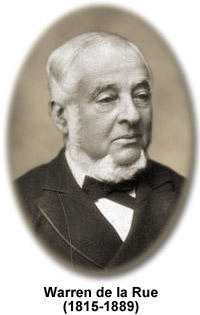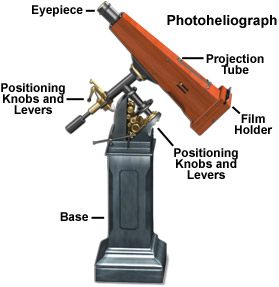Warren de la Rue
(1815-1889)

Warren de la Rue was a nineteenth century microscopist, astronomer, and chemist who invented an instrument for observing the sun, known as the photoheliograph. The son of a prominent businessman in the stationery industry, de la Rue was born in Guernsey on January 15, 1815 and was educated in Paris. Upon graduation, he accepted a position at his father’s firm and even invented a machine that made envelopes in 1851. However, science was his real passion, and he carried out experiments and research during his spare time.
De la Rue’s studies were broad and he published papers on a number of different topics. His investigations of photoactive chemicals, electrical discharge in gaseous substances, and batteries are especially notable, the latter resulting in the invention of the silver chloride cell. De la Rue was also intrigued by optics and carried out many experiments in the field, some of which tested the wave theory of light. He is most remembered, however, for his pioneering role in astrophotography. His adaptation of the wet-plate process to the photography of the moon in the early 1850s allowed for highly improved images of the lunar body, which were unsurpassed in their detail for many years. Early success in his astronomical ventures led de la Rue to establish a new English observatory in Cranford, Middlesex, and in 1854, he was approached by the overseers of the renowned Kew Observatory who were seeking a way to produce daily photographs of the sun, a project originally proposed by John Herschel. De la Rue designed a special telescope for the project dubbed the photoheliograph.
The initial photoheliograph designed by de la Rue was built under his supervision by Andrew Ross and Company. The instrument, which was equipped with an achromatic objective and a Huygenian eyepiece, produced images about four inches in diameter. De la Rue’s photoheliograph was installed at Kew in 1858, though several years would pass before many of the small technical difficulties associated with the instrument were overcome. Photographs of the sun were obtained with the photoheliograph at Kew on almost every sunny day for more than a decade, at which time the device was moved to the Royal Observatory at Greenwich, where regular solar photography was carried on with it until 1882. De la Rue published some of the findings from his own observations with the photoheliograph in Researches on Solar Physics (1865-68). Notably included in the work is de la Rue’s account of an expedition to Spain in 1860, which he undertook in order to photograph a total eclipse of the sun that occurred on July 18. The images produced during that trip were the first to definitively demonstrate that the corona seen around the moon during a solar eclipse is a phenomenon associated with the sun rather than the moon.

De la Rue retired from active astronomy in 1873, but before that time he had discovered more than 500 nebulae. Most of the many instruments he had accumulated over the years were donated to the observatory at Oxford University. On April 19, 1889, de la Rue died in London. Yet, his pioneering work had paved the way for many future astronomers, and his many contributions to science were widely acknowledged during his lifetime. A member of the Royal Society of London and the Royal Astronomical Society, de la Rue received the highest honors bestowed by both associations, the Royal Medal (1864) and the Gold Medal (1862), respectively. He was also a member of the Chemical Society, of which he was elected president twice, and the prestigious French Academy of Sciences. The original de la Rue photoheliograph is retained at the Science Museum of London.
